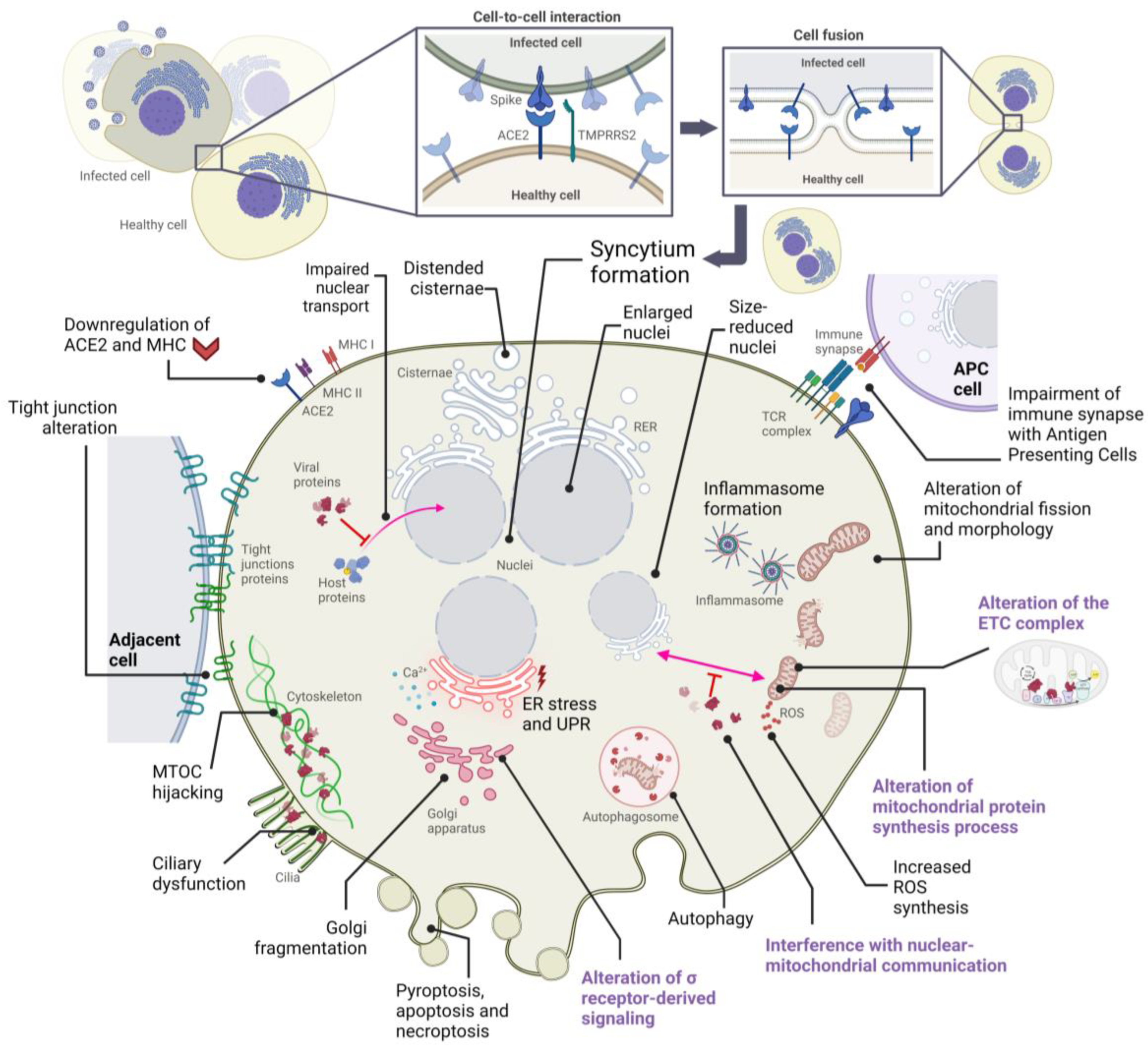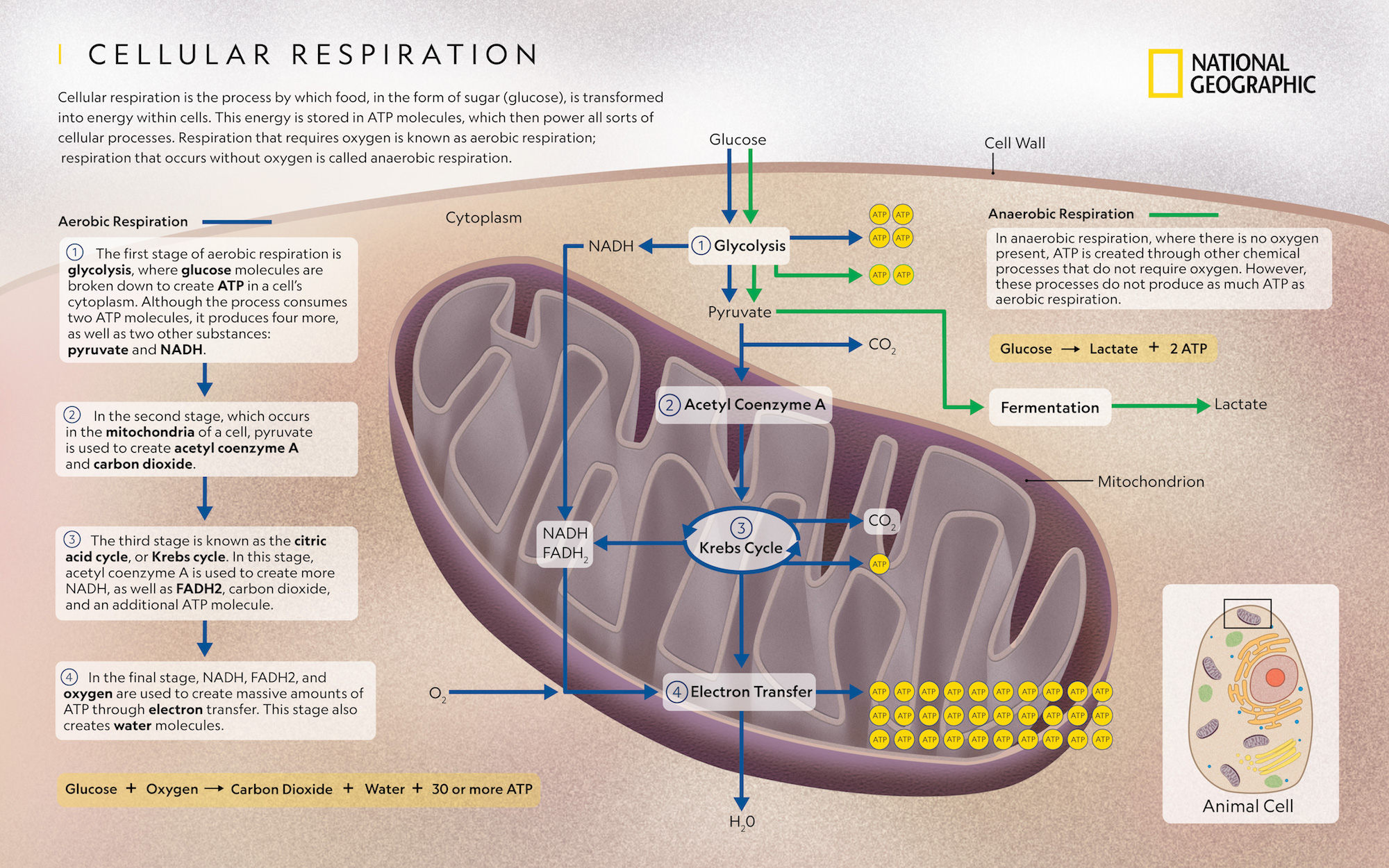Introduction to Cellular Respiration
Cellular respiration is a fundamental process that occurs in living organisms to generate energy by breaking down organic molecules. It is a series of metabolic reactions that take place in the cells, converting glucose and oxygen into ATP (adenosine triphosphate), the energy currency of cells. This process is crucial for the survival and functioning of all aerobic organisms.
Key Stages of Cellular Respiration
Cellular respiration consists of three main stages: glycolysis, the citric acid cycle, and oxidative phosphorylation. Each stage plays a specific role in extracting energy from glucose and other nutrients.
Glycolysis
Glycolysis is the first stage of cellular respiration, occurring in the cytoplasm of the cell. During glycolysis, glucose is broken down into pyruvate, producing a small amount of ATP and NADH.
Citric Acid Cycle
The citric acid cycle, also known as the Krebs cycle, takes place in the mitochondria. It further breaks down pyruvate to generate more ATP, NADH, and FADH2 through a series of chemical reactions.
Oxidative Phosphorylation
Oxidative phosphorylation is the final stage of cellular respiration, where the majority of ATP is produced. It involves the electron transport chain and ATP synthase, utilizing the high-energy electrons carried by NADH and FADH2 to generate ATP.

The Overview of Cellular Respiration Process
Cellular respiration is the process through which cells convert glucose and oxygen into energy, carbon dioxide, and water.
Stages of Cellular Respiration
Cellular respiration consists of three main stages: glycolysis, the citric acid cycle (Krebs cycle), and oxidative phosphorylation (electron transport chain and chemiosmosis).
Glycolysis
Glycolysis occurs in the cytoplasm and involves the breakdown of glucose into pyruvate, producing a small amount of ATP and NADH in the process.
This process is anaerobic, meaning it does not require oxygen to function.
The Citric Acid Cycle (Krebs Cycle)
In the Krebs cycle, the pyruvate from glycolysis is converted into Acetyl-CoA, which then enters the mitochondria to generate more ATP through a series of redox reactions.
This cycle also produces NADH and FADH2, which carry electrons to the next stage of cellular respiration.
Oxidative Phosphorylation
Oxidative phosphorylation involves the electron transport chain and chemiosmosis to create the bulk of ATP in cellular respiration.
During this stage, the NADH and FADH2 produced in the previous steps donate electrons, which are used to pump protons across the inner mitochondrial membrane, establishing an electrochemical gradient.
This gradient drives ATP synthase to produce ATP from ADP and inorganic phosphate, completing the energy production process.
The Events of Glycolysis
Glycolysis is the initial step in cellular respiration, which plays a crucial role in breaking down glucose and producing energy in the form of ATP. The process of glycolysis involves a series of interconnected reactions that occur in the cytoplasm of cells.
Step 1: Glucose Phosphorylation
Glucose, a six-carbon sugar molecule, is phosphorylated by the enzyme hexokinase, using ATP to form glucose-6-phosphate.
Step 2: Isomerization
The glucose-6-phosphate molecule undergoes isomerization to form fructose-6-phosphate catalyzed by the enzyme phosphoglucose isomerase.
Step 3: Phosphorylation of Fructose-6-Phosphate
Fructose-6-phosphate is further phosphorylated by ATP in the presence of the enzyme phosphofructokinase to form fructose-1,6-bisphosphate.
Step 4: Cleavage
Fructose-1,6-bisphosphate is split into two three-carbon molecules, glyceraldehyde-3-phosphate (G3P) and dihydroxyacetone phosphate (DHAP) by the enzyme aldolase.
Step 5: Oxidation and ATP Formation
Glyceraldehyde-3-phosphate undergoes oxidation, yielding 1,3-bisphosphoglycerate and NADH, while ATP is generated by substrate-level phosphorylation, forming ATP and 3-phosphoglycerate.
Step 6: ATP and Pyruvate Formation
The remaining steps involve further enzymatic reactions that ultimately lead to the production of ATP and pyruvate molecules as the end products of glycolysis.

The Steps of the Krebs Cycle
The Krebs Cycle, also known as the citric acid cycle, is a series of chemical reactions that occur in the mitochondria of cells, playing a crucial role in cellular respiration.
1. Acetyl CoA Entry
Acetyl CoA, a molecule derived from pyruvate, enters the Krebs Cycle to begin the process.
2. Citrate Formation
Citrate is formed by the combination of acetyl CoA and oxaloacetate. This step is catalyzed by the enzyme citrate synthase.
3. Isocitrate Production
Isocitrate is formed by the isomerization of citrate, a step facilitated by the enzyme aconitase.
4. Alpha-Ketoglutarate Formation
Isocitrate is oxidized to form alpha-ketoglutarate with the help of the enzyme isocitrate dehydrogenase.
5. Succinyl-CoA Production
Alpha-ketoglutarate is further oxidized to form succinyl-CoA, and CO2 is released in this step. This reaction is catalyzed by alpha-ketoglutarate dehydrogenase.
6. Succinate Formation
During this step, succinate is produced from succinyl-CoA with the help of succinyl-CoA synthetase.
7. Fumarate Generation
Succinate is oxidized to form fumarate by the enzyme succinate dehydrogenase, which also plays a role in the electron transport chain.
8. Malate Synthesis
Fumarate is hydrated to produce malate, a reaction catalyzed by fumarase.
9. Oxaloacetate Regeneration
Finally, malate is oxidized to regenerate oxaloacetate, closing the cycle and preparing for another round of the Krebs Cycle.
The Electron Transport Chain (ETC) Process
The Electron Transport Chain (ETC) is a crucial component of cellular respiration, representing the final stage in the process. It occurs in the inner mitochondrial membrane and involves a series of protein complexes that transfer electrons, ultimately producing ATP, the cell’s primary energy source.
Complexes Involved
The ETC comprises several protein complexes, including Complex I (NADH dehydrogenase), Complex II (succinate dehydrogenase), Complex III (cytochrome bc1 complex), Complex IV (cytochrome c oxidase), and ATP synthase.
These complexes work collaboratively to shuttle electrons along a chain, leading to the pumping of protons across the inner mitochondrial membrane.
ATP Production
As electrons move through the ETC, they lose energy, which facilitates the pumping of protons. This creates a concentration gradient that drives ATP synthase to produce ATP through a process known as chemiosmosis.
This ATP production is critical for various cellular functions and is essential for sustaining life processes in organisms.

Regulation and Coordination of Cellular Respiration
Cellular respiration is a complex metabolic process that involves the breakdown of glucose to produce energy in the form of ATP. The regulation and coordination of cellular respiration are crucial for maintaining energy balance within the cell.
Role of Enzymes
Enzymes play a key role in regulating cellular respiration by facilitating the various metabolic reactions involved in the process. Enzymes like ATP synthase are responsible for generating ATP through oxidative phosphorylation.
Importance of Oxygen
Oxygen acts as the final electron acceptor in the electron transport chain, which is a critical step in cellular respiration. Without oxygen, the process of oxidative phosphorylation cannot occur efficiently, leading to a decreased ATP production.
Cellular Respiration in Different Organisms
Cellular respiration is a fundamental process that provides energy to living organisms by breaking down glucose and other organic compounds. The process varies slightly among different organisms but generally consists of three main stages: glycolysis, the citric acid cycle, and oxidative phosphorylation.
Plants
In plants, cellular respiration occurs in all living cells, including roots, stems, and leaves. During the process, plants take in oxygen and release carbon dioxide. Additionally, they undergo photosynthesis, which produces glucose to be used in cellular respiration for energy production.
Animals
Animal cells also undergo cellular respiration to generate energy. The process takes place in the mitochondria of the cells, where glucose is broken down to produce ATP (adenosine triphosphate), the energy currency of the cell. Animals breathe in oxygen and exhale carbon dioxide as a byproduct of respiration.
Significance and Impact of Cellular Respiration
Cellular respiration is a vital process that fuels the activities of living organisms by converting nutrients into energy in the form of adenosine triphosphate (ATP). This process is crucial for the survival and functioning of all cells, from single-celled organisms to complex multicellular organisms, including humans.
Energy Production
Cellular respiration is the primary way in which cells generate ATP, the energy currency of the cell. ATP powers various cellular processes such as muscle contraction, nerve impulse transmission, and synthesis of macromolecules essential for growth and repair.
Metabolic Regulation
Cellular respiration plays a key role in regulating metabolic pathways within cells. By controlling the breakdown of glucose and other organic molecules, cellular respiration helps maintain the balance of energy production and consumption in the cell.
Frequently Asked Questions
-
- What is cellular respiration?
- Cellular respiration is the process by which cells break down glucose into energy, carbon dioxide, and water. This energy is stored in the form of ATP (adenosine triphosphate) and is essential for the functioning of the cell.
-
- What are the main stages of cellular respiration?
- The main stages of cellular respiration are glycolysis, the citric acid cycle (Krebs cycle), and oxidative phosphorylation (electron transport chain and chemiosmosis).
-
- In what organelle does cellular respiration take place?
- Cellular respiration takes place in the mitochondria of the cell. The mitochondria are often referred to as the powerhouse of the cell due to their role in producing ATP through cellular respiration.
-
- What is the correct order of events for cellular respiration?
- The correct order of events for cellular respiration is glycolysis, followed by the citric acid cycle, and finally oxidative phosphorylation. These stages work together to efficiently extract energy from glucose molecules.
-
- Why is cellular respiration important?
- Cellular respiration is vital for the survival of living organisms as it provides the energy needed for various cellular processes. Without cellular respiration, cells would not be able to function properly and sustain life.
Final Thoughts
In conclusion, understanding the correct order of events for cellular respiration is crucial for grasping the intricate process through which cells generate energy. By following the sequence of glycolysis, the Krebs cycle, and the electron transport chain, cells efficiently extract energy from glucose molecules. This comprehensive guide has shed light on the vital role of each stage in producing ATP and the exchange of energy-carrying molecules. Remember, cellular respiration is a continuous and complex series of reactions that sustain life in all living organisms. Delving deeper into these steps can enhance your knowledge of cellular functioning and metabolism. Stay curious, explore further, and keep learning about the marvels of cellular respiration!



